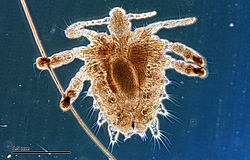Pediculosis
Template:Infobox - disease Pediculosis (pediculosis, infestation) is an itchy parasitic dermatosis caused by human lice, which can be further divided into:
- pediculosis capitis;
- pediculosis corporis;
- pediculosis pubis (sometimes referred to as phthiriosis).
Pediculosis capitis[edit | edit source]
Etiology and epidemiology[edit | edit source]
This type of pediculosis is the most common and is caused by head lice (Pediculus capitis). It is 2−4 mm long, oval and lives practically only in the hair. It breeds eggs (nits), which stick to the hair near its attachment. [1] Of these, after approximately 6 days, [2] the larvae hatch and mature within 2-3 weeks.
The disease mainly affects preschool and chool children (groups) and often their family members. Lice transmission usually occurs directly; nindirect transmission is possible eg. through a ridge, cap, etc.
Pathogenesis and clinical picture[edit | edit source]
Lice have a stabbing suction system and feed on the host's bloodstream. At the same time, saliva enters the wound (it can transmit, for example, typhus or Volyn fever), which causes skin irritation and severe itching. Petechiae and urticaria are found in the sting areas. Scratching creates linear excoriations that can become secondarily infected. [2] Nits adhere firmly to the hair and are most abundant above the temples, behind the earlobes and in the back. Regional lymph nodes tend to be enlarged.
Pediculosis corporis[edit | edit source]
Etiology a epidemiology[edit | edit source]
The disease is caused by a 3−4,5 mm lice (Pediculus corporis). It lives in clothes and also sticks nits on them, which one female puts 150−300 on them. [3]
At present, pediculosis corporis is almost non-existent in developed countries; homeless people and groups with a low hygienic standaed, or in emergency conditions. [2] Transmission occurs mainly through contaminated clothing and bedding.
Patogenesis and clinical picture[edit | edit source]
Lice suck especially in the places of tight adhesion of clothing, where we find itchy papules and excoriations. Impetigo and eczematization may occur − cutis vagantinum. As with head lice, they cause irritation and itching of saliva, which can transmit, for example, spotted fever or recurrent fever. [2]
Pediculosis pubis (phthiriosis)[edit | edit source]
Etiology and epidemiology[edit | edit source]
In this case, the etiological agent is lice (Phthirus pubis), a 1,5−2 mm large lice with a triangular body living in areas with abundant apocrine sweat glands - especially in pubic hair, but also in the anogenital and axilla areas, rarely in the exyebrows. [3]
It is transmitted through sexual intercourse (even indirectly through laundry, etc), especially promiscuous people are affected.
Patogenesis and clinical picture[edit | edit source]
There are pathognomic gray-blue spots the size of the lens at the site of sting − maculae coerulae, caused by degradation of hemoglobin by enzymes present in the saliva of the cells. The itching is mild [3], so we usually do not find excoriation.
Diagnosis and differential diagnosis[edit | edit source]
Pediculosis capitis − diagnosis is made on the basis of severe itching in the foregead and identification of adults or nits.
Pediculosis corporis − finding lice and nits in clothing, lesions all over the body and especially in the places of tight adhesion of clothing.
Pediculosis pubis − itchy gray-blue macules typically in the genital area, adult card or nits there.
Eczema, impetiginized eczema, psoriasis, tinea capitis are possible in the differential diagnosis.
Therapy[edit | edit source]
The treatment is aimed at eliminating adult lice and embryos in nits.
Pediculosis capitis:
- shampoo with 1% malathion;
- shampoo with 1% permethrin or carbaryl − repeatedlly, does not kill nits;
- lindane (Jacutin gel) − wash after 3 days;
- various oils (soy, coconut) − impassable airways of lice.
Note.: vinegar water is ineffective. [1] [2] [4]
Pediculosis corporis:
- mainly disinfection of clothes, especially boiling. [2]
Pediculosis pubis:
- insecticides with 0,5 % malathion;
- preparations with 1% permethrin or carbaryl − repeatedly;
- also treat sexual partners. [2]
Links[edit | edit source]
Source[edit | edit source]
[edit | edit source]
- ↑ Jump up to: a b
- ↑ Jump up to: a b c d e f g
- ↑ Jump up to: a b c
- ↑





